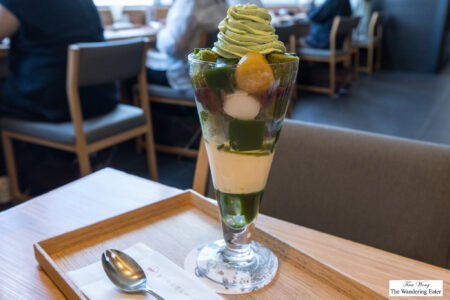
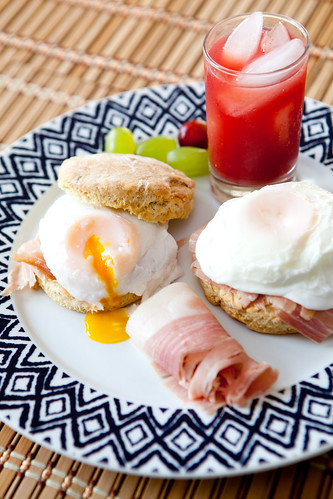
Homemade goose fat biscuits topped with sliced Johnston Country Ham and poached eggs
Easter, or any major holiday, is always a feast at home.
Since I have this wonderful ham from Johnston Country Hams, I couldn’t resist starting Easter morning with homemade goose fat biscuits (it’s based mainly from this recipe, except one third of the fat is with Kerry Gold butter) topped with sliced the said ham, poached eggs and a smear of Dijon mustard to cut the salt and flaky biscuit.
Of course, there’s more…
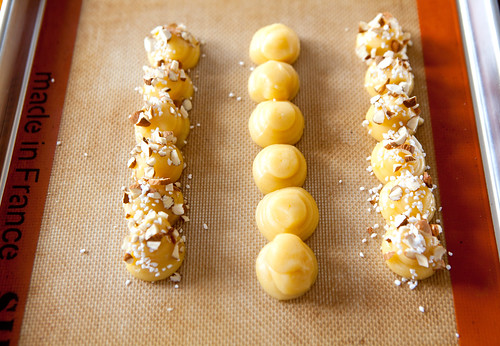

Homemade Gourmadise Fraise, Orange, Cardamome from Pierre Hermé’s Pastries cookbook
For afternoon tea, I baked for my family the Gourmadise Fraise, Orange, Cardamome (Strawberry, Orange, and Cardamom Delight) from Pierre Hermé’s Pastries. This cookbook, despite some of its flaws (I have the original edition and their second edition has corrections; and this particular recipe yields at least 2-3 times more filling than pâte à choux) is still my go-to for desserts to impress both my taste buds and my guests.
This dessert is Hermé’s take of the eclair. Crunchy yet airy and soft then the layer of bright orange marmalade then came the brief moment of intense vanilla pastry cream and the wave of whipped cardamom custard takes over with an undercurrent of fresh, sweet strawberries carried throughout. My family was silent while eating this – and that’s unusual.



Worm grass soup, Asparagus, peas and shredded country ham with balsamic vinegar, and Chinese sweet and sour spareribs
As dinner came, my family cooked up a very expensive soup, worm grass soup simmered for three hours with pork and chicken creating this deep flavorful soup that is restorative. (The worm grass costs about $22,000 US Dollars per pound) The arguably healthiest dish we had was the asparagus, peas and shredded country ham salad with balsamic vinegar (loosely based on Bon Apetit recipe) that was fresh and it does scream spring.
As for the main courses, we had Chinese sweet and sour pork spareribs (糖醋排骨) that was fried until golden brown then stir fried in a mixture of “old vinegar,” soy sauce, sugar, salt, and black pepper.
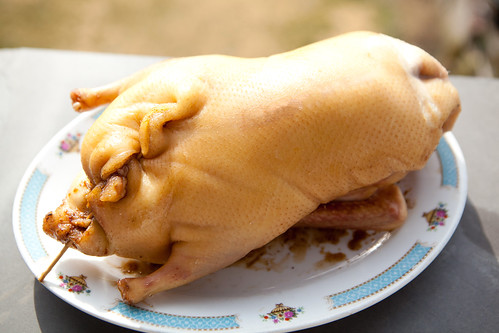
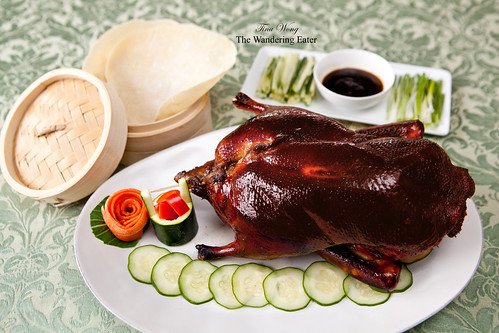
Homemade Peking-style duck basking/drying out in the sun and after roasting
But the pièce de résistance of the entire day was the homemade Peking-style duck. The day before, the duck was cleaned, marinated, and air-dried. The day of the dinner, the duck gets roasted while suspended in air with meat hooks. Here’s the recipe:
Peking-style duck
Ingredients
1 6-pound Peking duck (fresh preferred, gutted, rinsed, patted dry)
For the marinade
8 tablespoons hoisin sauce
4 tablespoons Chinese ground bean sauce
2 teaspoon salt
2 teaspoons five spice powder
2 stalks fresh scallions, cut in half
4 slices of fresh ginger thinly slice
2 tablespoons soy sauce
1 teaspoon sugar
1/2 teaspoon fresh ground pepper
For coating
1 black tea bag (nothing fancy, something like a regular Lipton or Tetley)
3 star anise
4 tablespoons honey
Directions
1. Take your cleaned, prepped duck and set it on a large platter. Take a hand powered air pump that is fitted with a needle pump needle, pierce the skin of the duck and pump it. Don’t worry, it won’t explode on you; all it would do is that the air would leak out. The intention is to separate the skin from the body and to allow more air to circulate throughout the duck.
2. Take a wok or large stockpot fill it halfway with water and bring it to a boil. Add the tea bag and star anise into the boiling water and let it simmer for 1 minute. Place the duck gently into the flavored tea water and quickly work a ladle to pour the mixture over the duck for 30 seconds or until the duck takes on some of the brown-red color. Remove, drain, and pat dry the duck. Set the duck on a sheet pan with a rack.
3. Take a mixing bowl and pour all the ingredients for the marinade and mix. Pour the marinade into the cavity of the duck and rub the marinade over it internally. Take a clean wooden skewer, thread the opening of the cavity shut by overlapping and pushing the skewer as you move along the cavity. Once you are the end, push forcefully yet carefully the tip of the skewer into the body. Trim the excess skewer.
4. Coat the duck with honey. Set the duck on the rack and let it rest/marinade in the refrigerator overnight in an area where the duck will not contaminate your other refrigerated foods.
5. About 3 hours prior to roasting, remove the duck from the refrigerator to get the duck to room temperature. Preheat the oven to 325°F and set one of the oven racks to the highest position and one to its lowest position. Place a meat hook (or two, if needed) securely onto the duck’s wings so that it can be suspended. Place a clean sheet pan on the lowest oven rack and pour about 1/2-inch of water into the pan. Carefully take the hooked duck and suspend it over the pan. Let the duck roast for 45 minutes and then raise the temperature 425°F and let it roast for an additional 10-15 minutes until it reaches that desired mahogany brown. Remove the duck from let it rest for at least 15 minutes. Slice or chop the duck and enjoy.
To view more photos of this meal, please view the slideshow below (or CLICK HERE for my photo set):
[tylr-slidr userID=”hellokitty893112″ groupID=””]http://www.flickr.com/photos/hellokitty893112/sets/72157633128744503/[/tylr-slidr]


